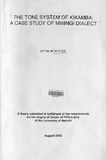| dc.description.abstract | This study is an investigation of the tone-system of the Mwingi dialect of Kikamba (MDK). It identifies and describes the tone patterns of the MDK as well as their lexical and grammatical functions. It also shows the relevant processes of tone association.
The research was based on the Autosegmental theory of phonology as presented by Goldsmith (1990) and other authorities referred to in this work, as the model for representing, analysing and describing tones and their associations.
Chapter one gives the background to the problem of this study and states the objectives and hypotheses of the study. It also gives a review of the relevant literature and states the theoretical framework within which the study has been conducted.
Chapter two examines the phonological and morphological phenomena relevant to the study. It describes the phonological and morphological structure of KTkambain general and shows what segments are specifically found only in MDK. It goes further to discuss the vowels and aspects of their phonological behaviour that may create changes in words, thus affecting tone in the language. This chapter also discusses the consonant system of Klkamba and gives a detailed description of the nouns by identifying the noun classes and showing the relationship between these classes. Finally it gives an overview of the syllable structure'. This chapter is vitai to this study as it provides the
phonological and morphological information to be used for the discussions raised later in the study.
Chapter three demonstrates the nominal structure of MDK words and their tonal patterns. The number and kinds of tones found in the MDK nouns are identified and their underlying and surface manifestations are discussed. Affixation on MDK nouns is also discussed together with its effect on the nouns. Furthermore, it is in this chapter where the functions of tone on MDK nouns are identified.
Chapter four deals with MDK verbs. It begins with a description of the segmental and tonal structures of the imperative verb. It then proceeds in a similar manner to describe the infinitive verb. This chapter also analyses the tensed MDK verb, looking at the present tense, the past tense and the future tense. The chapter demonstrates further the segmental properties of the tensed verb and the tonal structures that govern such properties.
Chapter five determines the association patterns of MDK tones identified in the nouns and verbs in chapters three and, four, respectfully. It goes further to show that the four contrastive surface tones of MDK have lexical and grammatical functions as illustrated in chapters three and four. It is demonstrated here that by use of Autosegmental rules
. the underlying behaviour of MDK tones can be discovered. Using the principles of
Autosegmental analysis and language specific rules Of MDK, it is demonstrated that
MDK tones associate with tone-bearing units to bring about the surface tones from the underlying ones.
Finally, chapter six gives a summary of the findings of this study. It also indicates the contribution of the study to Linguistics and draws conclusions from the research
findings. The chapter ends by indicating aspects of this study which require further
investigation. | en |

